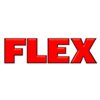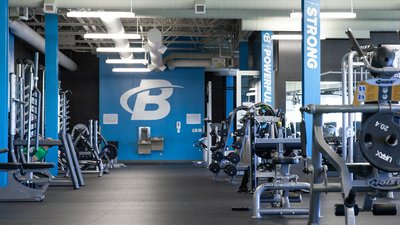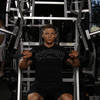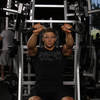When Phil Heath was dubbed the "next big thing" in early 2005, he had yet to earn his pro card. Of course, he did a couple of months later at the NPC USA Championships (heavyweight and overall), and with a win in his IFBB debut at the 2006 Colorado Pro and a week later at the New York Pro, it seemed that everything was unfolding as scheduled for the then-26-year-old nicknamed The Gift.
But life hasn't been without its speed bumps, like the fifth-place finishes at the 2007 Arnold Classic and the 2009 Olympia. And detractors said his physique was all arms, too narrow, and lacked the torso mass to ever beat the big boys where it mattered most, the Mr. Olympia. But it's seven years since his annunciation, and Heath has succeeded where so many others have tried and failed before him: He is Mr. Olympia, joining the 12 other men over the course of the past 47 years to hold the title World's Greatest Bodybuilder.
All the more remarkable is that he did it by eliminating the flaws that were supposed to have held him back. With delts bigger than his head, the word narrow no longer applies. His rear-double biceps pose is the best in the sport, and his expanded lower body is attached to the same tiny waist he had as an amateur. Oh, and the chest—full, round, and stacked from top to bottom and side to side—is one of the best in the game and adds that untouchable element to his front and side mandatory poses.
How did he do it? Read on to find out how the reigning king turned a less-than spectacular chest into a Sandow-worthy body part.
Q: Before we get into the workout and the exercises, what principles and techniques did you use to transform your chest over the years? It's always more informative to find out how a weak body part has been turned into a strong one, rather than one that's always been a standout, like arms, in your case.
Phil Heath: Time has been a great attribute. I received a lot of criticism early in my career, but people didn't realize that I'd only been training for three years when I turned pro.
Most guys have been doing this for close to a decade or more by the time they turn pro. I'm just coming up on 10 years this October.
So your weak points were a product of limited time, both in and out of the gym, as growth occurs after training.
Absolutely. All the normal lifts that bodybuilders do, we didn't do them in basketball. That's why you see improvement every year. Because I don't have as much experience as most guys, I've had to be smart about everything I do. I didn't have the luxury of a lot of trial and error. I had to be very intelligent.
There's no way in hell I could have achieved what I have without being a good student and listening to the wisdom of others who have been doing this a lot longer than I have. I evaluate what I'm doing and how it affects my body.
I see guys who are in the gym all the time, but their bodies are not a reflection of that. They look the same from year to year and that has to do with the fact that they're not evaluating the effect of their efforts. Just going to the gym is not enough. Are you getting the results you want?
Be critical of what you're doing. Whether you compete or do it as a hobby, you want to see results. If you're not improving, change what you're doing.
What were your early chest workouts like? I'm guessing that like most guys, the bench press was probably the most important exercise in the world.
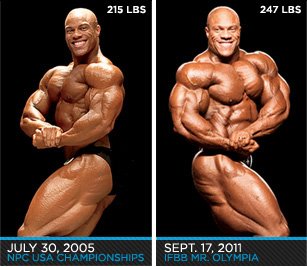
{{caption}}
Yeah, I did lots of flat benching in the beginning. But I realized that I preferred the feel of dumbbells. There's less risk of injury and you get a better range of motion.
Plus, each side has to work independently, which builds superior symmetry.
At the 2005 Olympia Weekend, you entered a bench-press competition. I think you got 46 reps with 225 pounds. Pretty impressive.
I didn't think anybody remembered that! I came in second to Jeramy Freeman [IFBB pro]. I've gone as heavy as 405 for 12 reps, but that was an ego thing, just to say, "Yeah, I did it." But I didn't feel it was going to build an Olympia-caliber chest.
Knowing what you do now, what would you tell yourself if you could go back in time?
That's easy. When you start out lifting, your main concern is, How much can I lift, because when someone asks you, "How much can you bench?" we all want to ramble off a pretty big number.
Anybody who's ever been inside a gym knows that there's no way around this. But I've been there and done that. As you get older and start focusing on why you're doing this in the first place, which is to build a better physique—or chest, in this case—you realize that the heavy weight at all costs isn't the most efficient way to reach your goal.
Instead, you start focusing on the feeling of the pecs as they move the weight, rather than just using them along with your shoulders and arms to help you get the bar up so you don't look like a fool in the gym.
Sometimes you need to do your reps slower and, consequently, lighter and use different angles.
Phil Heath's Chest Workout
Training Split
- Sunday: Quads, Hamstrings, and Calves
- Monday: Chest
- Tuesday: Back
- Wednesday: Quads (AM), Hamstrings and Calves (PM)
- Thursday: Shoulders
- Friday: Back
- Saturday: Chest and Arms

BodyFit
$6.99/month- 2,500+ expert-created single workouts
- 3,500+ how-to exercise videos
- Detailed workout instruction
- Step-by-step workout tips
- Training at gym or at home
- Access to Workout Plans
- Access to Bodyfit App
- Store Discounts
Already have a Bodybuilding.com account with BodyFit? Sign In

What comes with BodyFit?

- Instructional Videos
Don't risk doing a workout improperly! Avoid injury and keep your form in check with in-depth instructional videos.

- How-to Images
View our enormous library of workout photos and see exactly how each exercise should be done before you give it a shot.

- Step-by-Step Instructions
Quickly read through our step-by-step directions to ensure you're doing each workout correctly the first time, every time.
The first movement in this workout is the Hammer Strength incline press. Why do you kick off your chest workout with this machine?
Upper chest has been priority one since I turned pro, so every workout begins with some sort of incline movement. It wasn't until recently that the gym I train at [Armbrust Pro Gym] got this machine, so I relied on barbells and dumbbells for most of my career.
This machine has been a big reason for my chest improvements, which proves that both free weights and machines have their uses.
What's so special about this machine, other than the fact that it makes for some pretty memorable photo ops? I'm thinking back to those great black and whites of Dorian Yates, Jay Cutler, and David Henry.
Now you can add me to that list! One of the advantages is that you can adjust the height of the seat, which translates to a slightly different angle of attack on the pecs.
A lot of inclines don't have that degree of variation; they're either too high or too low with not enough in-between slots to get it right where you like it.
What form pointers do you have for the gym rats out there?
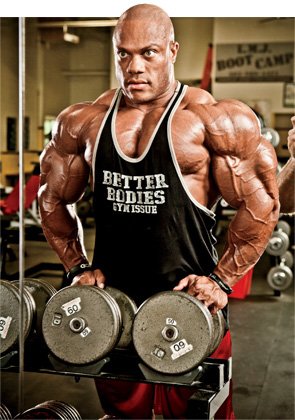
One of the things I make sure to do is keep my chin up. Once you start piling on the plates the tendency is to drop your chin to help you move the weight. Guess what? That means you're dropping your chest, too.
When that happens, you're taking stress off of your chest and transferring it to your front delts.
That brings up an interesting point. Guys with dominant shoulders and triceps find chest development a challenge. How do you circumvent that problem?
Tell me about it! Early on, my front delts and triceps were getting punished from heavy chest presses. But using both free weights and machines allowed me to focus more on isolating the pecs. I was able to feel how the chest was working.
It was really a matter of establishing a powerful mind-to-muscle connection. I know it sounds cliché because everybody says it, but it's absolutely true and you'll see the difference between guys who can do this and the ones who can't.
How far apart do you place your hands?
That's another plus to this piece of equipment. You can shift your hand spacing. The closer you go, the more inner chest you use—but you also involve more triceps and I need to keep my triceps out of the movement, so I tend to stick with a slightly wider grip.
You've got five plates on each side, and this was shot a couple of weeks before the [2011] Olympia. That's pretty heavy that close to the show.
Probably the biggest factor in my chest's improving over the past year has been my ability to train heavy enough with high intensity and be smart about it.
I don't back off the weight because I'm afraid, but at the same time I don't want to be an idiot and go out there, screaming and hollering to lift a weight that I really shouldn't be using and end up injured.
Now I can't train, and for a gym rat like me, especially with the Olympia on the line, that's like losing a limb. There comes a time when you have to ask yourself: "OK, what's the heaviest I can go and still get a ton of quality reps?"
Most people are more concerned with the poundage rather than how it's being used. I can tell you there are plenty of guys who put up 405 but not that many quality chests.
And these aren't weekend warriors I'm talking about but NPC competitors. I can scream and holler and talk sh-t, but that's not going to build my chest.
After warming up, you did four working sets. How many reps were you shooting for on each set?
My rep range stays between 8 and 12. If I can do more than 12 reps with a weight for a few sets, then I really should move up.
But if your gym doesn't have any heavier dumbbells or not enough weight—and I'm thinking of young guys who train at home and can't afford to buy more weight or maybe in a rec room or their apartment's fitness facility—do more working sets with that weight. If you can't overload the muscle with sheer poundage, do it with volume.
In one of my training videos, I used the 150s for incline dumbbell presses, and even though I was going for 12 reps, by the time I dropped them to the floor, I had done 22. The camera was there, and I was just feeling it that day, so what the hell, I went for it.
The biggest 'bells at my gym are the 170s, and I've done those for 8-10 reps, but the 22 reps with the 150s is far more impressive to me. Volume is a big factor in building my physique, so I try to take advantage of that when I can.
So after four sets, it's pretty safe to assume that your upper chest has been, um, hammered. What's next on the Heath Hit List?
There are two basic things you can do for chest: presses and flyes. Flyes are isolation moves because it's pretty much just your chest doing the work. They give you a better stretch because of the greater range of motion at the bottom.
Sometimes I like to alternate compound and isolation exercise for a different point of attack on the pecs.
This seems like a pretty simple exercise, but it's actually tough to master; few people do it correctly. What's the key to making it work?
The key is bending your elbows slightly and then keeping them fixed in that position. In my first year of lifting, I remember being told to think of it like hugging a giant tree. You don't want to go so heavy that you end up half-pressing the weight.
I know your routines are heavy on compound movements, but are flyes a staple as well?
I know a lot of experts will disagree with this, but the flyes make me believe I can expand my rib cage a little because of how wide and deep I can go with the movement. Plus, it just feels really, really good.
I'll be honest, watching Arnold Schwarzenegger do these in Pumping Iron made me want to do them. You see how massive his chest is on each rep. It has pretty much been a staple of my routines.
I noticed that you do not do the one thing that I see a lot of guys doing: touching the dumbbells together at the top.
I'm already getting a good contraction so I don't see the point. Plus, when you clang those weights together, the momentum could take them right into the negative part of the movement, which means that you are no longer in control.
Now we're on to another machine for the third exercise, the vertical chest press.
This is a very deceptive machine. You think that because you can bench 405 you should be able to do a ton of weight, but then you get on there and you feel it with just three plates on each side.
Do you think it's important to work on exercises that you may not be that strong on or comfortable with?
Any new movement that feels good makes you want to do it more. But what about the exercises that don't come easy?
There are times when I'll come back to an exercise after a long time away and I find that I'm really weak at it. I mean, I can't even use half the weight as the guy next to me uses, and I'm bigger than him!
Well, that motivates me to work that movement. Next thing I know, I'm recruiting different fibers because now my muscles have to adapt to something new.
Give your muscles a reason to grow. That's the heart and soul of bodybuilding.
Any performance pointers for the vertical chest press?
One thing I do is keep my back pressed against the pad, just as if I were lying down and pressing. The tendency is to lean forward, but when you do that, you bring your shoulders into play. I like throwing these in after dumbbells.
I'm getting pretty fatigued at this point, so it's nice to just get busy and not have to worry about balancing the weights.
The last exercise was the incline flye, but you did a cable version, which, outside of pictures in the magazines, you don't see too often in the gym.
Yeah, now we're back to the upper chest. I might do these with dumbbells or even on a pec deck, but this day I went with cables. The cables offer a couple of advantages. First, you get constant tension. There are no dead spots.
With dumbbells, there's not much happening at the top so you're tempted to rest. The cables are always pulling at you, so there's no chance of that happening. Second, you can cross your hands at the top. That will give you an even tighter contraction and work the inner chest a little more. And who couldn't use a little more cleavage?
And the form is exactly the same as on the dumbbell flyes, elbows fixed in a slightly bent position.
You keep a pretty good pace. Is that something that you're conscious of?
I learned that from Jay Cutler when we trained together for the first time back in 2006 to reduce my rest periods between sets. That's another way of increasing intensity. The closer I get to the show, the less I rest.
People don't realize how much time they spend resting or talking in between sets when they should be killing it. You're there to spur muscle growth, so get to it!
Your chest came up dramatically for the 2010 Arnold Classic. Your upper chest, in particular, was the best in the show. What improvements do you want to see in 2012?
I want to see the fullness that I have at four to five weeks out from the show. Anyone will tell you that they look great at four weeks out, minus the hard-edged separation and striations, like in the hams and glutes. Why can't I have both?
I watched the [2011 Olympia] DVD, and I would like my relaxed poses to be even stronger, and the chest plays a huge role in that. That's something I remember from watching Jay and Ronnie. They dominated from the moment they walked onstage. People were screaming for Ronnie when he walked out and hit a front relaxed; the same with all the multiple O winners.
When they stood there, people were already in awe. That's what I want. I want people to say I won the damn show before I even hit a pose.
What's different about this off-season versus last year?
I'm emphasizing dumbbell work. I can max out the Hammer Strength machine in contest mode, so during the off-season, imagine how heavy I can go.
It may not be the most effective tool for me. So I'll go back to the fundamentals and use more dumbbells.
I'll also go heavier and try a 5-7 rep range to build a different base so that I can grow into the show once I start my diet.
If you could go back in time, what would you do differently for chest?
I would have done more dumbbell work.
I didn't really do dumbbells on anything in the beginning. I remember barbell benching 315 for reps but not being able to handle the 120s for the same movement. That's a signal that there's a problem.
What advice do you have for those looking to improve their chests?
Find what works best for you and stick with it, but don't be afraid to venture outside of your comfort zone and challenge yourself. Sometimes you need to get your ass handed to you. That lights a fire under your butt.
And if you're not getting what you want out of a new exercise—after you've given it enough time—you still haven't lost. You learned something new. That's what the off-season is for.
It's like those 12-week programs you see in the magazine. The first few weeks, you're getting your ass kicked, but by the end, you're the one kicking ass and you can't wait to start the next program. It's tough at first, but put in the work and once you cross the finish line, you'll see it was worth it. It always is.
Let's talk about your training mindset now that you are Mr. Olympia. Your career has been a series of ups and downs. When you weren't winning, people questioned whether you were for real or just hype. Has that played a role in the way you approach your craft in the gym?
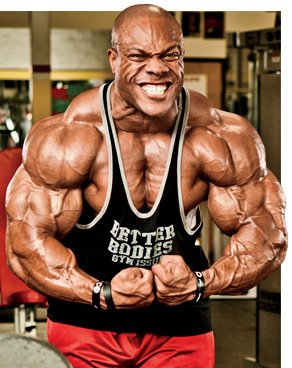
The challenge I issued to myself was, "Can I make the improvements that people have come to expect from me and I have come to expect from myself?" I've done it my whole career, making my strong points stronger but actually turning a weakness into a strength. How many guys can say that? Dudes have gotten bigger, but has anyone ever taken a weakness and made it a strength?
I want to be the guy that does it again and again, from year to year. I still look at pics from the Olympia and say I was probably five pounds better the week before the show. I won the NPC USA with no back or chest. I was all arms, and critics said that was all I'd ever be. Now I'm Mr. Olympia and you can't be Mr. Olympia without a back, chest, shoulders, and legs.
But I know that you can't sit on your butt. I can hold onto the Sandow only by improving. The size is there so now I get to really start sculpting and show the world the physique that I see in my mind.
Whether you like it or not, one of the questions after you won the Sandow was, Can he repeat? Can Phil Heath establish a dynasty like Lee Haney, Dorian Yates, or Ronnie Coleman?
I can't answer that. I'm enjoying this one. I'm only the 13th guy to win since 1965. That's hard to comprehend. I'm blessed to be in the company of very Mr. Olympia.
As my off-season is starting, the only thing on my mind is defending. I'm not thinking about how many I can win or anything like that. I want to enjoy the journey. Because getting there is half the fun.
What's your biggest motivation as you try to defend your Sandow?
People have told me that what they saw on that Olympia stage was new, something they hadn't seen before. That makes me excited because I'm just getting started and I know deep down in my heart that the best is yet to come.
I'm looking at pictures of myself from the show because that's the person I need to beat. I don't need to look at any forums because I will always be my harshest critic. It's never gonna stop.
The day I stop doing that is the day I need to walk away from the sport. That makes me want to try even harder to eclipse what I've done.
Who do you consider to be the biggest threats to your title?
Everybody's a threat. There are always going to be challengers, and I welcome them. I'm going up against the best in the world so this isn't supposed to be easy. It's my job to step up and meet the challenge face-to-face.
I know what it took to get here, and as I get older and gain more wisdom, I'll be even better. I'll be able to dial it in better. I know that all the guys [competitors] want a piece of me. They want what I have, but I'll be damned if I hand it over. I did whatever it took to get the Sandow, and now that I have it, I will do whatever it takes to keep it. The best is yet to come.
